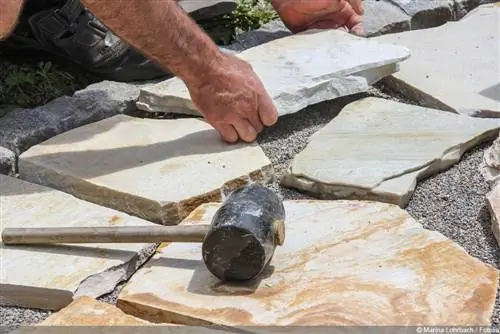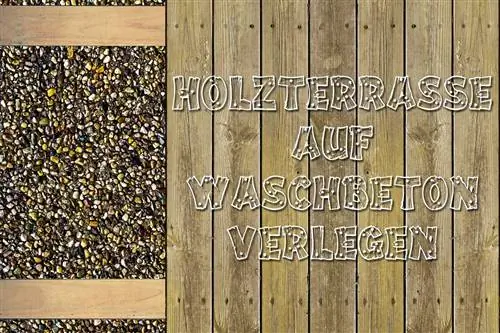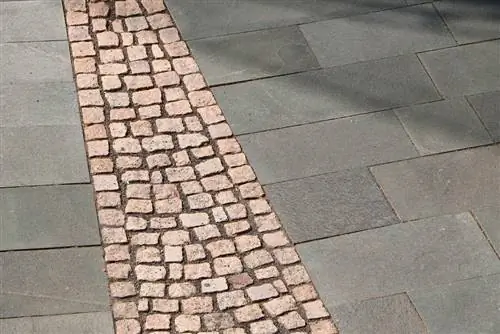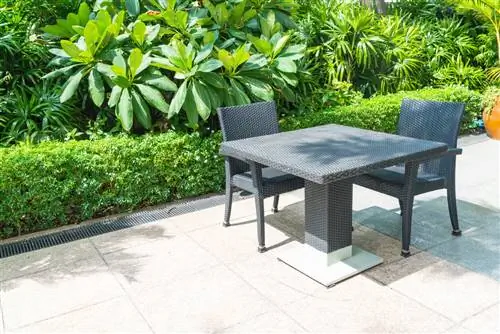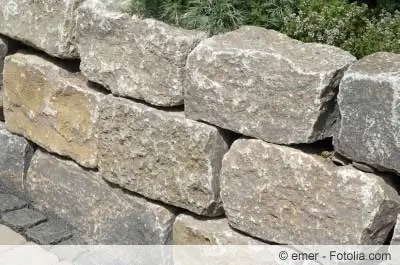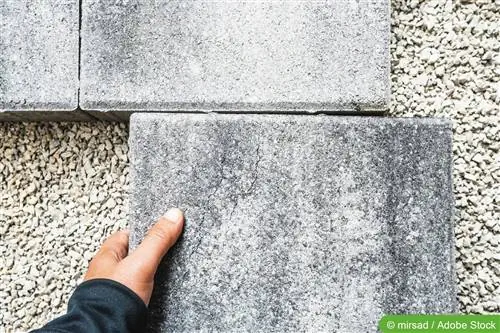- Author admin [email protected].
- Public 2023-12-17 03:39.
- Last modified 2025-01-24 12:45.
In most cases, slab coverings are laid wet, i.e. in a bed of concrete or mortar. However, this can be disadvantageous for terraces and other outdoor applications and is usually not necessary at all in terms of effort. Here you will find out how to lay natural stone slabs, such as polygonal slabs or slate slabs, without using expensive and complex cementitious building materials.
The alternative to concrete
Laying quarry stone slabs without mortar - is that even possible? Yes it works! Ultimately, the concrete only serves to hold the panels in place. This is at least as simple, cheaper and in many cases even more durable by placing the natural stone slabs in a bed of chippings. If the edge of the laid surface is fixed in its position, the panels secure each other against unintentional movement. And not just with polygonal panels, but also with rectangular or square panels. How the work is implemented can be easily understood using the following steps.
NOTE:
In general, the instructions can also be easily used to lay slate tiles. Overall, however, you should work particularly carefully, as slate has a much greater tendency to break, splinter or “slate” under tension, i.e. to split into its individual layers.
Substructure
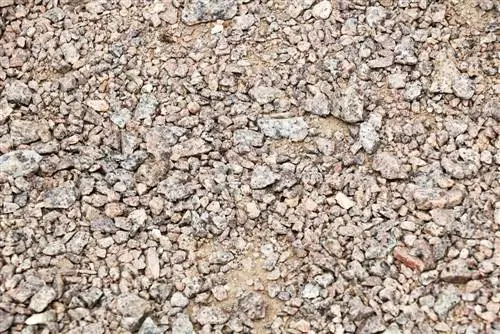
While laying in mortar is usually carried out on solid concrete floor slabs, laying in gravel does not require this solid but expensive substructure. Instead, it is sufficient to improve the subsurface so that it is load-bearing, does not move under the influence of water and frost and, of course, is level enough to allow installation.
The steps mentioned here are only necessary if a stable substructure does not already exist through a new building project or similar.
Required materials and supplies
- Mini excavator, alternatively spade, pickaxe and shovel
- Buckets, wheelbarrows etc.
- Spirit level
- Straight log, batten or other straight batten with a length of approx. 2m
- Plate vibrator
Procedure
- Dig existing subsoil to a depth of 80cm
- Dispose of excavated material properly, e.g. in a landfill, alternatively disposal via landscape gardeners, earthworks companies or similar
- Excavate on all sides approx. 40 centimeters beyond the edge of the pavement
- Introduce a frost-proof, water-draining and at the same time load-bearing substructure, material e.g. KFT (“combined frost protection and base layer”), or mineral concrete
- Compact the installed material with a plate vibrator after a layer thickness of approx. 30 centimeters, then apply further layers up to the target height
- Determine the upper edge of the substructure as follows: planned surface of the quarry stone slabs minus the slab thickness, minus five centimeters for the laying bed of the natural stone slabs
NOTE:
Mineral concrete is mentioned as a possible substructure. Despite the name, it is not a classic, cement-bound concrete. Instead, mineral concrete is a mixture of different gravel grain sizes, which can be compacted very well due to its composition and can therefore be made load-bearing.
Preparation for laying
Once the substructure has been created, frost, rising soil moisture and collecting rainwater can no longer harm the following covering made of natural stone slabs. Now it's time to create the right conditions for later laying the panels. These requirements include securing the edge of the covering against shifting, as well as creating an exact level on which the slabs then lie in one level and without thresholds or tripping hazards.
Required materials and supplies
- Bucket
- Hammer
- Rake / Straightedge
- Spirit level
- Guideline
- Carpenter's nails or other pegs
- Possibly trowel
- Tape measure / meter stick
The edge protection
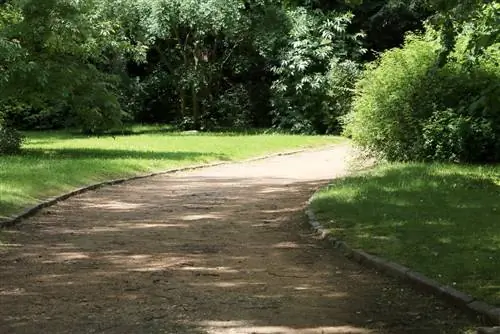
There are various options for securing the edge of the terrace against movements that then affect the entire area:
The Edge Angle
Using an edge angle requires no mortar at all. Mostly made of plastic, it is an angle profile whose protruding leg serves as a stop for the panels. The horizontal leg has a perforation that allows it to be attached to the substrate using long carpenter's nails or special pegs:
- Measure the exact position of the terrace edge
- Lay out the angle profiles and align them according to the measurement results
- Aids: Stretch the guide line over two pegs for straight lines
- Carefully drive in the securing elements and check the position of the profiles
The mortar wedge
If you don't want to choose a mortar bed for the panel surface, but can certainly use this material for details, you can alternatively use a mortar edge. Although this is only created after the panels have been laid, for better clarity this variant is already explained here:
- Mix mortar suitable for outdoor work according to the manufacturer's instructions
- Check the outermost row of panels again for precise positioning
- Apply mortar to a frost-proof substructure next to the edge panels and spread it in a wedge shape towards the panel
- Ideally keep the top edge of the wedge just below the top edge of the board
Curbs
Setting curbs requires a particularly high level of effort. In addition to creating a very good grip, they also enable a visual edge delimitation of the area equipped with polygonal plates. Low-height border stones are sufficient because, if the work is carried out correctly, they only have to absorb a small amount of lateral pressure:
- Stretch the guide line over the pegs, taking into account the alignment of the terrace edge and the desired upper edge of the borders and slab covering
- Create suitable outdoor mortar according to manufacturer's instructions
- Apply chunks of mortar in the area of the board ends on a frost-proof substructure
- Place the discount stones loosely on pieces of mortar, align them and press them lightly
- Align the rebates using a rubber mallet, hammer lightly into the mortar bed until the desired position is achieved
NOTE:
Based on the information on edge protection, you might rightly ask yourself whether these methods are visually appealing to the outside world. It should be noted at this point that once the work has been completed, the excess of the frost-proof substructure can be refilled with soil. After renewed greening, the overhang of the substructure is just as invisible as the securing of the edge of the terrace.
The Planum
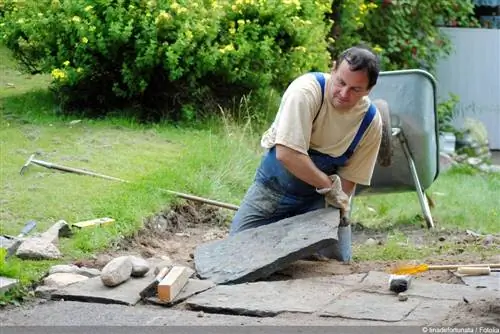
Once the edge of the terrace area is secured, the final level is created on which the panels are then placed. Fine grit, so-called noble grit, is used for this purpose. If the surface is created without any defects or hills, all common panel materials, including slate, can be laid on it without having to worry about unevenness or tripping hazards later.
NOTE:
We read again and again that terraces should be sloped at a gradient of around two to three percent for effective drainage. If this is desired, the guideline in the following description must be tilted in the direction of the desired gradient. When laying in a gravel bed, rainwater can also seep away through panel joints, so that the inclination is less important, especially with polygonal panels and other panels with large joint widths. Even smaller terraces can be aligned quite well without a slope, as less water can collect overall.
Required materials and supplies
- Judgment
- Spirit level
- Calculations
- Bucket
- Shovel
- Guideline with pegs
Procedure
- Apply fine grit, grain size ideally up to a maximum of 3-5 millimeters to the substructure between the edge boundaries and distribute roughly
- Set up the exact target height using a guide line on the edge of the plate
Tip:
Set up a guideline so that the top edge of the line indicates the guideline when the split surface has reached the target height
- Set up the spirit level on a straightedge and align the height in the area of the edge of the terrace according to the guideline
- Pull off the split using a straightedge horizontally or following the created gradient of the line
- Remove excess amounts of split, add if there are any missing areas and remove the area again
- Pull the straight edge crosswise from the sides of the terrace to eliminate waves when working in one direction
The relocation
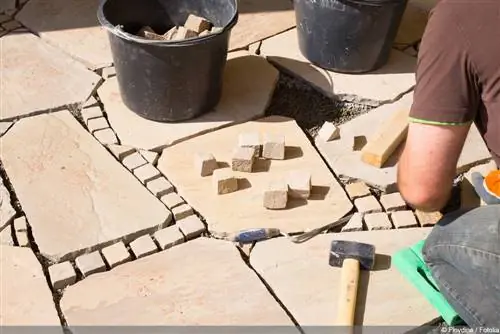
Now the last thing to do is to insert the desired panels on the created subgrade and between the existing edge boundaries. For the sake of simplicity, we assume that panels can be inserted without breakage or saw cuts.
Required materials and supplies
- Judgment
- Spirit level
- Guideline with pegs
- rubber hammer
Procedure
- Carefully place the selected panels into the split bed from one side of the terrace and press lightly
- If there are slight unevennesses in the split, carefully tap the slabs into a horizontal position with a rubber mallet
- Check the position regularly using a ruler and spirit level using a guideline
- Ensure the desired joint width between panels using a suitable spacer, e.g. wooden strip or specific plastic molding, remove temporary spacers later
- In the edge area if the surface does not end in full slabs, cut stones using a cut-off grinder and a suitable stone disc, making sure to chamfer the edges
- After laying all the quarry stone slabs, fill the joints with suitable joint sand, add sand to the terrace surface and sweep it in all directions with a broom, repeat the process after a few days due to the sand settling
Tip:
When laying slate tiles, trimming the edge tiles can be easier with a pointed hammer than with technical aids! But you should definitely familiarize yourself with the technology on a leftover piece beforehand! To create equivalent joints, special spacers can be used, which only attach to the lower half of the board thickness and therefore do not appear after the joints have been filled. They remain permanently in the joints and stabilize the surface against displacement of the panels against each other, especially during creation and until the joints are completed.
Why joints at all?
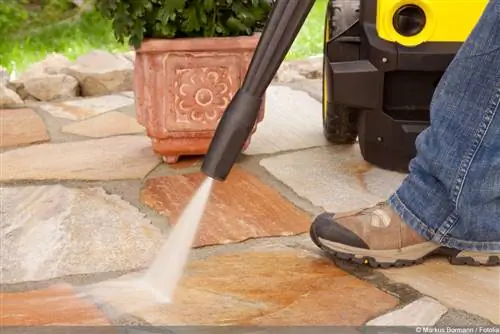
Inexperienced readers may now ask themselves why the stone slabs are laid with joints at all. If they were close together, they would be much more secure and at the same time more harmonious in terms of the appearance of the stone surface.
The joints between the panels fulfill several functions:
- Drainage option for rainwater
- Decoupling of the plates from each other, otherwise when one plate moves (tilting), there is also movement of neighboring plates
- Compensation option for dimensional tolerances between the panels
In addition, joints are also capable of concealing one or two inaccuracies in execution. Although we expect every do-it-yourselfer to do conscientious and precise work, even professionals are not immune to mistakes and are happy to use the advantages of panel joints for themselves.

